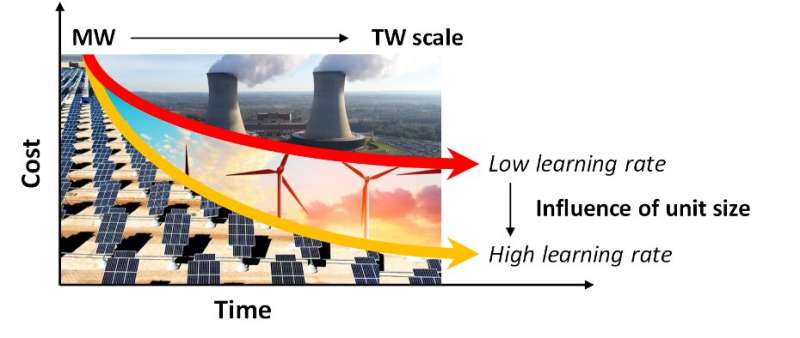'Think small, learn fast' might be the way to go for novel energy technologies

In a paper just published in the journal Joule, scientists from the University of Amsterdam (UvA) and TNO Energy Transition present an analysis of learning curves in energy technology and conclude that a focus on smaller unit size could facilitate faster cost reduction. According to Bob van der Zwaan, professor of sustainable energy technology at the UvA's Van 't Hoff Institute for Molecular Sciences (HIMS), this is particularly relevant for devices and processes capable of generating solar fuels, such as hydrogen, that may become essential elements of future energy systems.
For acceleration of the energy transition needed to mitigate climate change, cost reduction is crucial. The sooner sustainable technologies can outcompete technologies based on fossil fuels, the sooner they will be implemented and enable substantial reductions of CO2 emissions. Now, in a paper in the open-access journal Joule, researchers Bart Sweerts,Remko Detz,and Bob van der Zwaan present an analysis of the learning rates of 41 energy-related technologies, which suggests that unit size is inversely proportional to empirically observed cost reduction. Thus, with smaller units, the learning curve could be steeper and costs reduced faster.
According to Prof. Bob van der Zwaan, the observation that smaller mass-produced technologies may be learned faster than their larger custom-built counterparts is a key insight for technology developers, scientists, analysts and policymakers. Van der Zwaan says, "Especially in the field of solar fuels production, anticipating rapid cost reduction resulting from clever choices regarding system size may be essential for broad-scale use."
Quick implementation of improvements
As an example, Dr. Remko Detz presents the case of electrolysers that use renewable electricity for the CO2-free production of hydrogen. Such green hydrogen is important for making chemical production processes more sustainable and also offers a solution for heavy-duty transport. "As with solar cells, you could set out to manufacture electrolysers in units of relatively small size and combine many of these in larger factories of gigawatt scale. The manufacturing of such cells can be fully automated in processes in which small improvements can be quickly implemented. Our research indicates that this could potentially lead to faster cost reduction than the alternative of first designing larger electrolyser units of multiple megawatts and then combining these in lesser numbers to arrive at a gigawatt scale."
Bob van der Zwaan: "With our paper, we hope to ensure that these types of effects are carefully considered since there are large amounts of money involved. It is without a doubt that if we want to achieve the climate goals that we have fixed in the Paris Agreement, some technologies will have to be upscaled to terawatt capacity. This requires high investments so that a small improvement in the learning curve can quickly mean savings of many billions of euros."
Making a case for learning curve analysis
The researchers are aware that drawing robust conclusions from a comparative analysis of learning rates is far from straightforward. For instance, they point in their paper to the difficulty of directly comparing learning rates determined for different technologies, as there exists substantial variation regarding the methodologies used and the assumptions made. Adding to this, many learning rate analyses are solely based on the overall cost reduction of a technology. An analysis of the underlying factors contributing to these cost reductions should provide more insight into the validity of a comparison of learning curves. Also, the potential for 'learning-by-doing' as captured by reductions in costs differs substantially across technologies at different stages of maturity. However, they argue, there is ample reason to take learning curve analysis out of its recent lull and revisit the possible relevance of unit size in choosing and designing novel low-carbon energy technologies.
More information: Bart Sweerts et al. Evaluating the Role of Unit Size in Learning-by-Doing of Energy Technologies, Joule (2020). DOI: 10.1016/j.joule.2020.03.010


















